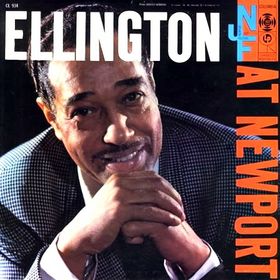Who: Duke Ellington (1899-1974), the greatest jazz composer of all time, and his 15-piece orchestra.
What: This album is a live recording of Ellington's legendary performance at the 1957 Newport Jazz Festival, which is widely considered the best performance of his career. At the time of the performance, Ellington's career (and the big band swing of the 1940s that he pioneered) was in decline due to the rise of bebop jazz. Here, Ellington and his band reinterpret his older classics in a hip way that not only revitalized his career, but also provided some of the most famous and important improvisational work of 1950s jazz.
Where: The Newport Jazz Festival in Newport, RI.
| Paul Gonsalves, the saxophone soloist from "Dimenuendo and Crescendo in Blue," with Ellington, ca. 1950s. |
When: Anytime, but it was simply wonderful on a sunny spring morning.
Why: This is a stunning and sophisticated album that even listeners who don't like jazz can enjoy. It strikes a perfect balance between traditional big band song structures and forward-thinking improvisation. The atmosphere between the band and the audience after the performance of "Diminuendo and Crescendo in Blue" has to be among the most thrilling live moments captured on record.
 |
| Elaine Anderson dancing during Ellington's performance at Newport RI, July 7, 1956. |
Microdose: This isn't really a "microdose" because it is the longest song of the concert by far, but this electrifying performance of "Diminuendo and Crescendo in Blue" (originally from 1937) must be heard to be believed. It features Paul Gonsalves's iconic 27-chorus saxophone improvisation, which was spurred on when Elaine Anderson (known simply as the "white woman in the black dress" for decades) jumped out of her box seat and started dancing at the stage, causing the rest of the audience to join her. According to those in attendance, the crazier she danced, the crazier the solo became. After the song ended, the audience was so energized and demanding that the band had to play three encores, while Ellington tried to calm them down.
Additional Dose: Ellington and Gonsalves are reunited 15 years later. This live footage from 1972 demonstrates the effortlessness and mutual admiration of the duo, as they glide into the smooth number.

No comments:
Post a Comment